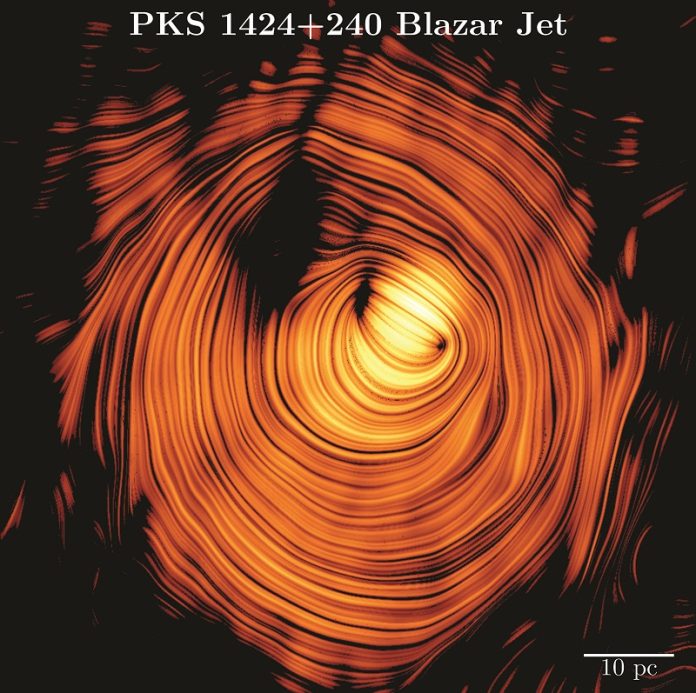
like the fiery “Eye of Sauron” from The Lord of the Rings.
But this isn’t fantasy—it’s a cosmic jet powered by a supermassive black hole, and it may have solved a mystery that has puzzled scientists for more than a decade.
The galaxy in question is a blazar called PKS 1424+240, located billions of light-years from Earth.
Blazars are a type of active galaxy where a supermassive black hole at the center devours surrounding matter, blasting out jets of plasma that shine across the universe.
PKS 1424+240 has long stood out because it is one of the brightest sources of both high-energy gamma rays and cosmic neutrinos ever detected.
The IceCube Neutrino Observatory in Antarctica identified it as a neutrino emitter, while ground-based Cherenkov telescopes confirmed its powerful gamma-ray glow.
The puzzle was that its radio jet appeared to move unusually slowly. Conventional wisdom suggested that only the fastest jets could generate such extreme brightness. Something didn’t add up.
Now, with 15 years of ultra-precise data collected by the Very Long Baseline Array (VLBA)—a continent-spanning radio telescope network—astronomers have stitched together the clearest image yet of the blazar’s jet.
What they saw astonished them: a beautifully ordered magnetic field forming a near-perfect torus, with the jet pointing straight at Earth.
“When we reconstructed the image, it looked absolutely stunning,” said Yuri Kovalev of the Max Planck Institute for Radio Astronomy, the lead author of the study. “We have never seen anything quite like it.”
The explanation lies in geometry and relativity. Because the jet is aimed almost directly at Earth, its radiation is dramatically boosted, appearing up to 30 times brighter than it would otherwise.
At the same time, this head-on alignment creates an illusion that the jet is moving slowly, even though it is racing at nearly the speed of light.
This rare perspective gave scientists the opportunity to look deep inside the blazar’s jet and map its magnetic field using polarized radio waves. The data suggest that the field has a helical or doughnut-like structure, which plays a vital role in guiding the plasma flow and accelerating particles to mind-boggling energies.
“Solving this puzzle confirms that active galaxies with supermassive black holes are not just accelerating electrons, but also protons—the likely source of the high-energy neutrinos we detect,” Kovalev explained.
The breakthrough is a major achievement for the MOJAVE program, a long-running project dedicated to monitoring black hole jets with the VLBA.
By linking radio telescopes across the globe in a technique known as Very Long Baseline Interferometry (VLBI), astronomers effectively create a telescope the size of Earth, capable of capturing the finest details in the faraway universe.
“When we started MOJAVE, connecting black hole jets to cosmic neutrinos seemed like science fiction,” said Anton Zensus, co-founder of the program. “Now our observations are making it a reality.”
The discovery not only solves the riddle of PKS 1424+240’s unusual brightness but also strengthens the connection between cosmic jets, neutrinos, and magnetic fields. It marks an important step forward in multimessenger astronomy, where light, particles, and other cosmic signals combine to reveal the universe’s most powerful engines.
And in the process, it has gifted us with one of the most striking cosmic images yet—a true Eye of Sauron blazing in deep space.
Source: Max Planck Society.



